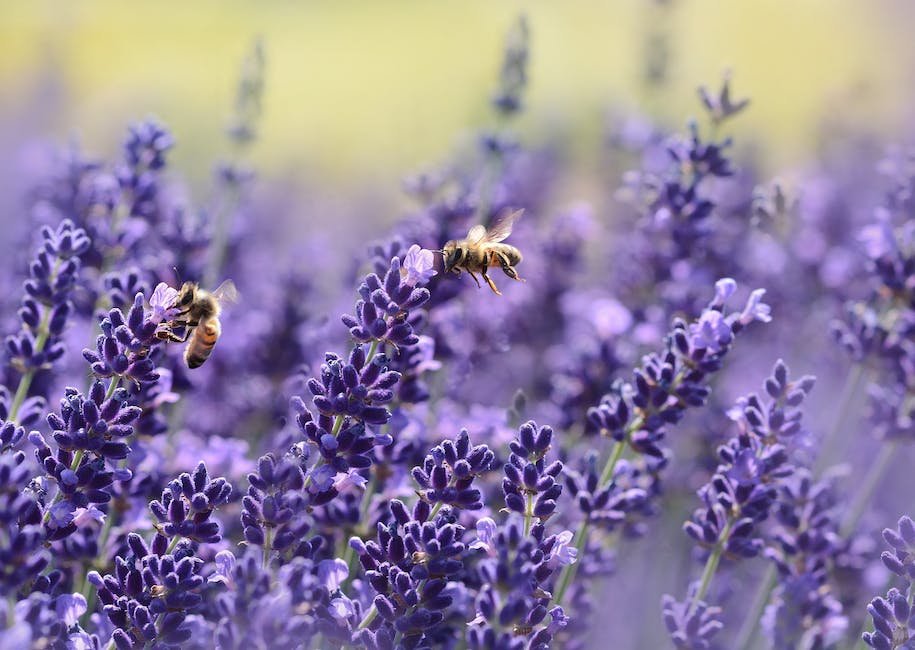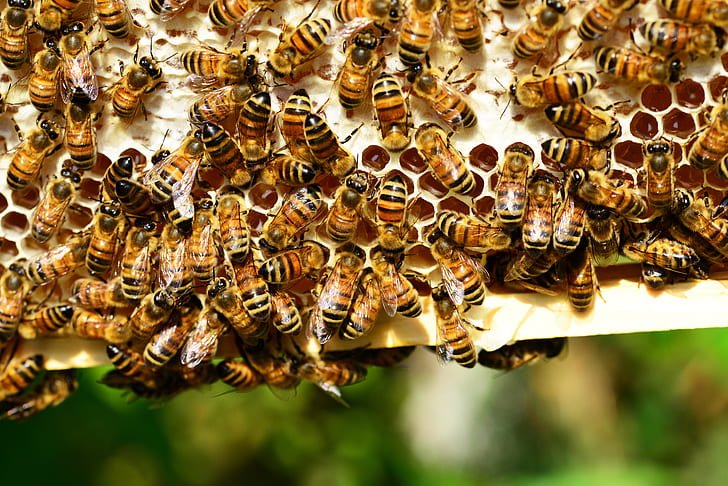Hushed whispers circulate among the vibrant blossoms, as tiny wings flutter with the precision of a delicate symphony. In this harmonious ecosystem, a complex society thrives, meticulously orchestrated by nature’s tiny architects — the bees. These industrious creatures, with their seamless cooperation, are not only unrivaled honey producers but also vital pollinators, playing an indispensable role in our agricultural systems. However, beneath their enchanting allure lies an enigmatic world of bee behavior, awaiting exploration by the curious minds of beekeepers. To truly comprehend the science of beekeeping, one must embark on a journey to decipher the intricate dance of these remarkable insects and unlock the secrets of their mesmerizing behavior.
Table of Contents
- The intricacies of honeybee communication and social organization
- The role of environmental factors in shaping bee behavior
- Understanding the foraging patterns and navigation skills of bees
- Tips for promoting healthy bee colonies through better hive management
- The significance of beekeeping practices in preserving pollinator populations
- Q&A
- To Conclude

The intricacies of honeybee communication and social organization
The fascinating world of honeybee communication
Within the bustling world of honeybees, intricate communication is the key to their incredibly organized social structure. These small creatures have evolved an intricate system of signals and dances to convey information essential for the survival and well-being of their entire colony. Through an array of sensory cues, honeybees are able to communicate complex messages with remarkable precision.
Vibrations: One fascinating aspect of honeybee communication is their ability to convey information through vibrations. Bees use this unique method to coordinate hive activities and alert their fellow bees about potential threats or nearby food sources. These vibrations can carry important details about the location, distance, and quality of a resource, enabling the colony to make collective decisions for the benefit of all.
Pheromones: Honeybees also rely on a sophisticated chemical language. They release pheromones, which are specialized scents, to communicate various messages. For instance, queen bees emit specific pheromones to signal their presence and maintain order within the colony. Worker bees, on the other hand, release alarm pheromones when they sense danger, triggering a rapid and synchronized defense response from their comrades.
Dances: Perhaps the most famous form of honeybee communication is the intricate dance known as the waggle dance. When a forager honeybee discovers a valuable nectar or pollen source, it returns to the hive and performs a series of dance moves to communicate the location of this precious resource. The angle of the dance relative to gravity conveys the direction, while the duration of the dance and its intensity provide information about the distance and quality of the find. This dance serves as a GPS system guiding the worker bees to productive foraging grounds.
Honeybee communication is a complex and awe-inspiring phenomenon that showcases the remarkable intelligence and social organization of these incredible insects. Through vibrations, pheromones, and dances, honeybees are able to exchange information and make cooperative decisions that ensure the survival and prosperity of their entire colony.

The role of environmental factors in shaping bee behavior
Bees, with their intricate social structures and remarkable communication systems, have always fascinated scientists and nature enthusiasts alike. While genetics play a significant role in shaping bee behavior, environmental factors also exert a profound influence on these fascinating creatures. From the availability of resources to temperature fluctuations and the presence of predators, the environment serves as an influential force in shaping their behavior.
Factors influencing bee behavior:
- Food availability: Bees’ foraging behavior is heavily influenced by the availability and quality of nectar and pollen in their surroundings. The variety and abundance of floral resources directly impact their feeding habits and overall colony productivity.
- Climate and weather: Temperature, humidity, and changes in weather patterns significantly affect bee behavior. Bees are known to adjust their foraging schedules and flight patterns based on temperature fluctuations, ensuring efficient thermoregulation within their hives.
- Predators and parasites: The presence of predators and parasites, such as wasps, birds, and mites, shapes bees’ defensive behaviors. These threats pose challenges that lead to the evolution of complex defense strategies, including the coordination and alarm signals among colony members.
- Landscapes and habitats: The landscape surrounding the bee colony can influence their behavior. Factors like the type of vegetation, proximity to pesticide-treated areas, and the presence of nesting sites affect bees’ navigation, communication, and reproductive patterns.
Understanding the intricate relationship between bees and their environment provides valuable insights into their ecology and conservation. By recognizing and mitigating the impacts of environmental factors, we can play our part in promoting the well-being and survival of these vital pollinators.

Understanding the foraging patterns and navigation skills of bees
Delving into the intricate world of bees reveals a fascinating display of foraging patterns and navigation skills. From the moment these industrious insects emerge from their hives, they embark on a mission to sustain their colonies and pollinate our ecosystems. Let’s take a closer look at the remarkable traits that enable bees to navigate their surroundings with precision and efficiency.
1. Foraging Patterns: Bees exhibit a structured and organized approach when it comes to collecting nectar and pollen. They follow a predetermined sequence known as a ”traplining” technique, where they visit specific flowers within a certain area before moving on to the next ones. This strategy allows them to maximize efficiency by minimizing the distance traveled and conserving energy. Through ongoing research, scientists are uncovering the complex signals and environmental cues that guide bees in their foraging endeavors.
2. Navigation Skills: Bees possess an innate talent for navigation that astounds researchers and nature enthusiasts alike. These remarkable insects rely on a combination of sensory information, including visual cues, olfactory signals, and even the Earth’s magnetic field, to chart their course. Through remarkable memory and learning capabilities, bees create a mental map of their surroundings, allowing them to return to their hives with incredible accuracy, even after extensive foraging trips. This sophisticated navigation system lies at the core of their survival strategy and ensures the strength and success of the entire colony.

Tips for promoting healthy bee colonies through better hive management
Ensuring the well-being and vitality of bee colonies is paramount for both beekeepers and the environment. By implementing effective hive management techniques, you can help support thriving bee populations. Here are some valuable tips to promote healthy bee colonies:
- Regular monitoring: Consistent hive inspections allow you to spot any potential issues early on. Keep an eye out for signs of pests, diseases, or unusual behavior. This enables you to take prompt action to prevent further complications.
- Provide adequate food: Bees require a diverse and abundant food source. Planting a variety of pollinator-friendly flowers and plants in close proximity to hives can ensure bees have access to nectar and pollen throughout the year. Supplementing their diet with sugar water or pollen patties during periods of scarcity can also be beneficial.
- Maintain hygiene: Cleanliness plays a vital role in hive management. Regularly remove debris, excess propolis, and old comb to prevent the buildup of pathogens or pests. This reduces the risk of infection and promotes colony health.
- Control Varroa mites: Varroa destructor mites are a major threat to bee colonies. Implementing effective mite control measures, such as using organic treatments, monitoring mite levels, and employing selective breeding for naturally resistant traits, can help keep mite infestations in check.
By incorporating these tips into your hive management routine, you can contribute to the longevity and productivity of your bee colonies. Together, let’s ensure a thriving future for our buzzing friends.
The significance of beekeeping practices in preserving pollinator populations
Beekeeping practices play a crucial role in safeguarding the delicate balance of pollinator populations that profoundly impact our ecosystem. These practices not only support the survival of honeybees but also contribute to the conservation of other pollinators such as butterflies and bumblebees. Here are three key reasons why beekeeping is of utmost significance in preserving pollinator populations:
1. Pollination Powerhouse: By providing a safe haven for honeybees and nurturing their colonies, beekeepers help maintain a robust population of these industrious insects. Honeybees are exceptional pollinators, and their diligent foraging efforts ensure the transfer of pollen from male to female plants, facilitating fertilization. This process leads to the production of fruits, vegetables, nuts, and seeds, which are vital sources of nutrition for both humans and animals.
2. Ecosystem Health: Beekeeping practices not only benefit honeybees but also contribute to the overall health of ecosystems. As pollinators move from flower to flower in search of nectar and pollen, they inadvertently assist in the reproduction of countless plant species. This intricate dance of pollination helps maintain biodiversity, preserve natural habitats, and sustain food chains. By actively engaging in responsible beekeeping, we foster ecological stability and create a harmonious environment for other pollinators.
3. Conservation Catalyst: Beekeepers are conservation catalysts, propelling initiatives and raising awareness about the importance of protecting and preserving pollinator populations. Their role extends beyond maintaining colonies; they actively advocate for sustainable agricultural practices, pesticide reduction, and the establishment of diverse habitats that support not only bees but also various indigenous pollinators. By engaging in beekeeping, individuals contribute to the larger cause of safeguarding our environment and ensuring the continued existence of these invaluable pollinators.
Q&A
How do bees communicate with each other?
Bees communicate through a dance known as the “waggle dance.” By waggling their bodies and making buzzing sounds, they share information about the location and quality of flower sources with their fellow colony members.
What is swarm behavior and why do bees swarm?
Swarming is a fascinating collective behavior of bees, where a large group of bees leaves their hive to form a new colony. This natural process occurs when the colony becomes overcrowded, and the old queen takes a part of the worker bees with her to find a new home.
How do honeybees maintain the temperature inside the hive?
Honeybees regulate the temperature inside their hive by flapping their wings to create air circulation and evaporation. Additionally, they cluster together to generate heat during colder periods, while creating air vents to release the excess heat when it gets too hot.
What is the role of the queen bee in a hive?
The queen bee is the mother of the entire colony. Her primary role is to lay eggs, ensuring the growth and survival of the hive. She also emits pheromones that maintain harmony and unity among the worker bees.
Why do bees make honey?
Bees make honey as a food source to sustain the colony during the winter months when flowers are scarce. By collecting nectar from flowers and transforming it into honey through enzymatic processes and evaporation, bees create a vital energy reserve for their survival.
What is the importance of pollination in bee behavior?
Pollination is crucial for the reproduction of flowering plants. Bees, while foraging for nectar, inadvertently transfer pollen between flowers of the same species, allowing fertilization to occur. This process not only ensures the survival of plants but also promotes biodiversity and the production of fruits and seeds.
How does bee behavior contribute to the biodiversity of ecosystems?
As bees collect nectar from various plants, they inadvertently transfer pollen, aiding in cross-pollination and genetic diversity within plant populations. This essential role in pollination helps maintain the health and stability of ecosystems, supporting the growth of different plant species.
To Conclude
As you delve into the enchanting world of beekeeping, you quickly realize that the science behind it is as fascinating as it is intricate. Bee behavior, with all its orchestrated movements and intricate dances, holds the key to a harmonious coexistence between humans and these remarkable creatures. Through understanding their behaviors, we can unlock the secrets that make them such vital players in our ecosystem.
From the humble beginnings of their hives to their intricate communication techniques, every action performed by bees is a masterpiece in itself. Their collective intelligence knows no bounds, as thousands of tiny minds come together to form a unified force that tirelessly works towards the common goal of survival. They navigate the vast expanse of the sky with precision, pollinate countless flowers, and ultimately gift us with the golden elixir we call honey.
However, in the face of increasing threats such as climate change, habitat loss, and pesticide use, understanding bee behavior becomes more crucial than ever. By studying their intricate dances and understanding their foraging habits, we can identify patterns and act as stewards of these invaluable insects. In doing so, we protect not only their existence but also our own.
Unraveling the science behind beekeeping is a never-ending journey, one that constantly challenges our perceptions and leaves us in awe. It is through this understanding that we form a deeper bond with nature, and recognize the delicate tapestry in which we are all interconnected. So, as you don your beekeeping suit and venture into their world, remember to embrace the wonder, the mystery, and the beauty that lies within bee behavior. For in doing so, we not only learn from them but also become their champions, ensuring that the melodious hum of these extraordinary creatures continues to grace our gardens and fields for generations to come.
As an affiliate, my content may feature links to products I personally use and recommend. By taking action, like subscribing or making a purchase, you’ll be supporting my work and fueling my taco cravings at the same time. Win-win, right?
Want to read more? Check out our Affiliate Disclosure page.